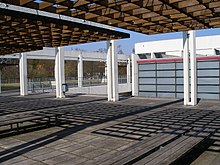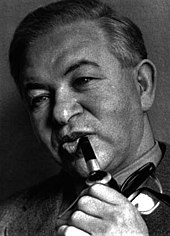Arne Jacobsen
Arne Emil Jacobsen (born February 11, 1902 in Copenhagen ; † March 24, 1971 there ) is considered one of the most important international architects and designers in Denmark in the 20th century. His designs followed the style of functionalism .
Live and act
Arne Jacobsen grew up in a middle-class family. His father was a Jewish merchant and his mother a former bank clerk. At a young age he drew a lot of the flora and fauna of Denmark. Jacobsen learned the profession of stonemason by 1924. At his father's request, he studied architecture at the Royal Danish Academy of Art in Copenhagen, where he graduated in 1927. He then worked for two years as an architect in the municipal building department, until in 1929 he joined forces with the architect Flemming Lassen to design the “House of the Future” . The round building with a helicopter landing pad on the roof was to be presented at an exhibition of the Copenhagen Chamber of Architects. For the furnishing of the house Jacobsen developed some furniture made of metal, this was Jacobsen's first work as a designer.
In the following years Jacobsen worked on various construction projects, the first major project was the Bellavista settlement in Klampenborg . The settlement on the beach of the Øresund consisting of several houses, a restaurant and the Bellevue Theater was completed in several construction phases between 1932 and 1935. Nearby he built the Skovshoved gas station in 1936 . Together with Erik Møller , he won the architecture competition for the new Århus Town Hall in 1936 , which was completed in 1942. During the German occupation of Denmark in World War II , the Jewish Jacobsen and his second wife fled to Sweden from the National Socialists.

In 1956 Jacobsen became professor emeritus at the Royal Danish Academy of Art. In addition to teaching, he continued to work on projects. In the same year he started work on the SAS Royal Hotel in Copenhagen. Jacobsen designed all the details of the city's first skyscraper himself, from the building to the textiles to the restaurant's cutlery. Some of his well-known furniture designs, such as Egg and Swan , come from the SAS project completed in 1960.
In 1964 his works were shown at documenta III in Kassel in the Industrial Design department . In his later projects, such as the design and construction of the new school building for the Hamburg Christianeum or the Danish Embassy in London , he worked with the architects Otto Weitling and Hans Dissing , who continued some of the projects after Jacobsen's death in 1971. One of his last works was the National Bank of Denmark building in Copenhagen, which he started in 1966. It wasn't completed until seven years after his death.
style
Jacobsen can be assigned to modern functionalism . His buildings and design work were influenced by Ludwig Mies van der Rohe , Le Corbusier and the Bauhaus . His perfectionism is reflected in his work . He should have worked almost permanently. For him, recovery consisted of turning to another area of creative activity.
architecture
Jacobsen's architecture is characterized by a clear design language oriented towards geometry and material. This was less derived from the function , as it is often portrayed , but arose from Jacobsen's rigid modernist concept, to which his family had to submit in everyday private life. Jacobsen was seen by critics as an architectural dictator who designed buildings so rigidly that there was no room for personal change requests.
In addition to his work in Denmark, including at the SAS Royal Hotel in Copenhagen from 1960, he was also active internationally. He designed buildings erected in Germany, including the building of the Christianeum high school in Hamburg-Othmarschen and the administration building of Vattenfall GmbH in Hamburg's City Nord in the Winterhude district. Further designs by Jacobsen were realized in Berlin ( model estate Südliches Hansaviertel ), Hanover (glass foyer in the Great Garden ), Mainz ( town hall and company headquarters Novo Nordisk ), Castrop-Rauxel and in Burgtiefe on Fehmarn .
design


In contrast to the architectural work, many of his design projects are strongly oriented towards organic forms. Jacobsen developed objects reminiscent of the formal language of abstract art, which were characterized by a concise and clear shape. Jacobsen's closeness to nature may have played a part in this different emphasis on design: Jacobsen was a passionate botanist. Several of his seating furniture , which were created from 1950, became popular. These have names such as The Ant , The Egg , The Swan , Grand Prix or Series 7 . The latter is the best-selling chair of all time. His seating furniture was all developed together with the Fritz Hansen company, which is still producing it today.
From 1955 to 1969 he designed hanging and floor lamps for Louis Poulsen with great success. The AJ floor lamp in particular experienced a revival at the beginning of this century.
His cutlery series AJ was also well known : Stanley Kubrick chose it for the film 2001: A Space Odyssey, made in the 1960s .
In the course of building development, Jacobsen constructed three wall clocks for three important architectural buildings in his career. The "Roman Wall Clock" for the Aarhus Town Hall (1942), the "City Hall" for the Rødovre Town Hall (1956) and the "Bankers Wall Clock" for the National Bank of Denmark (1971). These later became design classics under the Rosendahl Timepieces brand, under further development with the designer Teit Weylandt, who was previously head of the product development department at Arne Jacobsen. Today these clocks are available as wall clocks and table clocks for the household, which are still manufactured according to strict requirements according to Jacobsen's original sketches.
The Cylinda Line / Cylinder Line utensils designed by Jacobsen for the manufacturer Stelton are modern classics. They were reinterpreted by Paul Smith for the company's 50th anniversary in 2010.
honors and awards
- 1925: Silver medal for a chair design at the Paris World Exhibition
- 1936: Eckersberg Medal
- 1954: Honorary Award of the International Art and Architecture Exhibition in Sao Paulo for the Massey Harris Building
- 1955: CF Hansen Medal
- 1957: Grand Prix at the XI. Triennale di Milano
- 1962: Medal of Honor from the Academic Association of Architects
- 1963: Fritz Schumacher Prize
- 1964: Extraordinary member of the Akademie der Künste (Berlin) , architecture section
- 1966: Honorary Doctorate in Oxford, England
- 1968: Honorary doctorate in Glasgow
- 1969: Pio Manzu gold medal from the Academy of Liberal Arts in San Marino
- 1971: Gold medal from the Academy of Architecture in France
literature
- Charlotte & Peter Fiell: Scandinavian design. Cologne 2005 ISBN 3-8228-4115-3
- Andrew Hollingsworth: Danish Modern. Gibbs Smith, Layton (Utah) 2008, ISBN 1-58685-811-4 , from p. 107.
- Louisiana Museum of Modern Art : Arne Jacobsen. Absolutely modern. Hatje Cantz, Ostfildern 2003, ISBN 978-3-7757-1290-3 .
- Carsten Thau and Kjeld Vindum: Arne Jacobsen. Copenhagen 2002, ISBN 978-87-7407-230-0 .
- Félix Solaguren-Beascoa: Arne Jacobsen - Approach to his complete works 1926-1971. Copenhagen 2002, ISBN 978-87-7407-270-6 .
- Tobias Faber: Arne Jacobsen . Hatje, Stuttgart 1964
Web links
- Literature by and about Arne Jacobsen in the catalog of the German National Library
- Arne Jacobsen. In: arch INFORM .
- Arne Jacobsen and the Christianeum
- Information about Arne Jacobsen on the Deichtorhallen website
- Biography of Arne Jacobsen at Stylepark
- Documentation about Arne Jacobsen from Fritz Hansen
- Materials by and about Arne Jacobsen in the documenta archive
- Arne Jacobsen at Fritz Hansen (English)
- Arne Jacobsen at the Tagwerc design agency with texts on his drafts and his design philosophy
Individual evidence
- ↑ Ariane Hoffmann: February 11, 1902: The birthday of the Danish designer ( Memento from July 21, 2015 in the Internet Archive ), WDR 3 , ZeitZeichen , February 11, 2012, MP3 file, 14 min.
- ↑ rosendahl.com: Arne Jacobsen
- ↑ Database entry Arne Jacobsen at the AdK
| personal data | |
|---|---|
| SURNAME | Jacobsen, Arne |
| ALTERNATIVE NAMES | Jacobsen, Arne Emil (full name) |
| BRIEF DESCRIPTION | Danish designer and architect |
| DATE OF BIRTH | February 11, 1902 |
| PLACE OF BIRTH | Copenhagen |
| DATE OF DEATH | March 24, 1971 |
| Place of death | Copenhagen |





